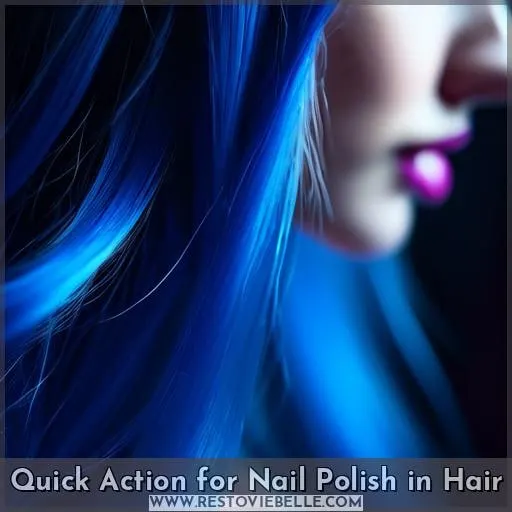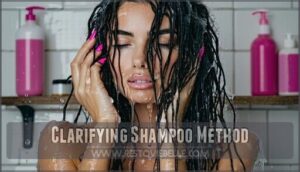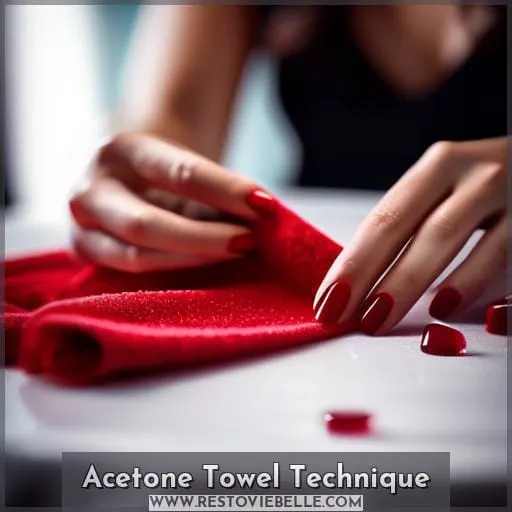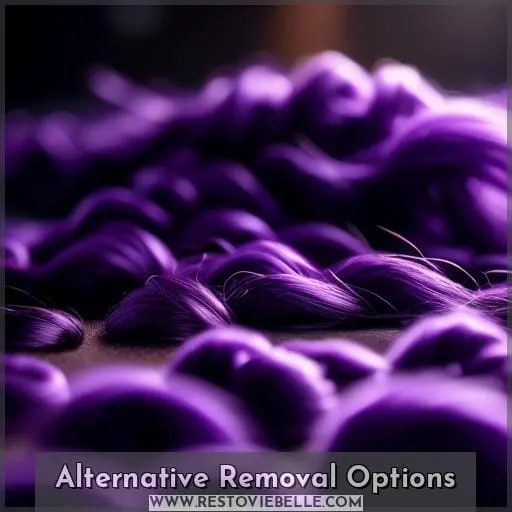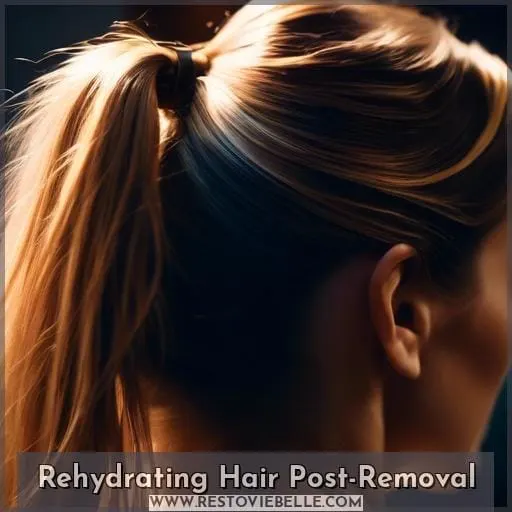This site is supported by our readers. We may earn a commission, at no cost to you, if you purchase through links.
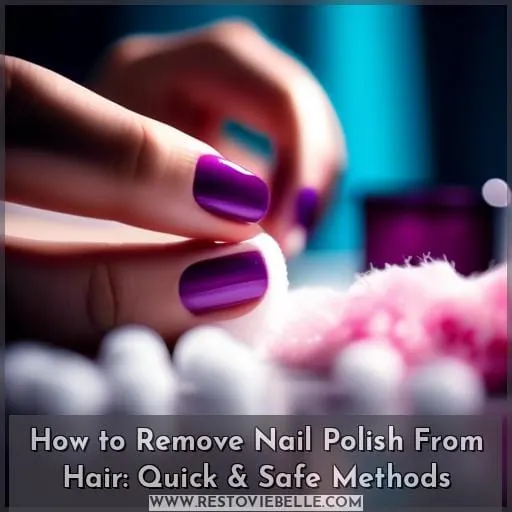 Like a splash of unexpected color on a pristine canvas, nail polish in your hair can be an unwelcome surprise.
Like a splash of unexpected color on a pristine canvas, nail polish in your hair can be an unwelcome surprise.
Whether it’s a mishap during a manicure or a curious child’s experiment, getting nail polish out of your hair doesn’t have to mean a trip to the salon for a chop. With some household items and a bit of patience, you can safely remove the polish and restore your hair’s natural flow.
Let’s dive into quick and safe methods to free your locks from the clingy grip of nail polish.
Yes, you can remove nail polish from your hair by using non-acetone polish remover for wet polish or conditioner and oil for dry polish to gently work it out.
Table Of Contents
- Key Takeaways
- Quick Action for Nail Polish in Hair
- Clarifying Shampoo Method
- Acetone Towel Technique
- Alternative Removal Options
- Rehydrating Hair Post-Removal
- Frequently Asked Questions (FAQs)
- Can nail polish in hair affect its color or cause discoloration over time?
- Is it safe to use nail polish removal methods on dyed or chemically treated hair?
- How can one differentiate between nail polish and other substances in hair, and does the removal process vary?
- What are the environmental impacts of using chemical removal methods for nail polish in hair?
- How can individuals with sensitive skin or allergies safely remove nail polish from hair without causing irritation?
- Conclusion
Key Takeaways
To remove nail polish from hair, gentle methods such as using conditioner, oils, or clarifying shampoo can be effective, especially when massaging the product into the hair and working it in a downward motion to ease out the polish.
Immediate action is crucial when nail polish gets into hair; acting quickly to wipe away wet polish and using cold methods like ice cubes can prevent the polish from setting and make it easier to remove.
Safety precautions should be observed, such as avoiding eye and mouth contact with nail polish remover, using products in well-ventilated areas, and consulting a professional if the polish cannot be removed after several attempts.
It is advised to avoid harsh chemicals and abrasive tools like rubbing alcohol, hydrogen peroxide, dry cleaning solvent, acetone remover, nail files, hair brushes, or emery boards, as these can damage the hair.
Quick Action for Nail Polish in Hair
When nail polish finds its way into your hair, acting swiftly can make a significant difference in the removal process. Start by using a towel to gently dab and wipe away any wet polish, avoiding the urge to peel or tug at it, which could harm your hair.
This approach not only prevents the polish from setting but also minimizes damage to your hair strands. Remember, patience and gentle handling are your best allies in keeping your hair free from nail polish mishaps.
Act Immediately to Prevent the Polish From Setting
When nail polish finds its way into your hair, acting swiftly can make all the difference between an easy clean-up and a sticky situation.
- Prevent the Polish from Setting: Time is of the essence. The quicker you act, the less likely the nail polish will dry and harden, making it more challenging to remove.
- Use a Towel for Wet Polish: If the nail polish is still wet, gently dab (don’t rub) the area with a towel to remove as much polish as possible without spreading it further.
- Gather Your Arsenal: Have your tools ready. This includes acetone or non-acetone nail polish remover, cotton balls or rounds, and optionally, baby oil or essential oils to minimize damage to your hair.
- Choose Your Method: Depending on the severity and your comfort, select a removal method. Acetone is effective but harsh, while oils and conditioners offer a gentler approach.
Use a Towel to Wipe Away Wet Polish
To swiftly tackle the mishap of wet nail polish finding its way into your hair, grabbing a towel for immediate action is your best bet.
This isn’t just about keeping your hair’s health in check; it’s about outsmarting that sneaky polish before it decides to settle in for a long stay.
Imagine your hair as a party and the wet polish as the uninvited guest – you’d want to show it the door ASAP, right?
So, wrap a towel around the affected strands, gently dabbing, not rubbing, to avoid turning a small problem into a hair-raising saga.
This quick action can save you from a sticky situation, ensuring your hair remains as vibrant and polish-free as intended.
Clarifying Shampoo Method
When it comes to removing nail polish from your hair, the clarifying shampoo method stands out as a straightforward and effective approach.
First, wet the affected area of your hair and apply a small amount of clarifying shampoo directly to it. Using your fingers, work the shampoo into a lather, ensuring that the nail polish-coated strands are thoroughly covered.
Allow the shampoo to sit on your hair for about 15 to 20 minutes, giving it ample time to break down both wet and dry nail polish. After the waiting period, rinse your hair with warm water to remove all traces of nail polish.
For the best results, follow up with a deep conditioning treatment to rehydrate your hair strands, restoring their natural shine and softness.
Application and Waiting Time
To effectively remove nail polish from your hair using the clarifying shampoo method, start by wetting the affected hair.
Apply a small amount of clarifying shampoo directly onto the area with nail polish. Using your fingertips, gently massage the shampoo into your hair, creating a lather. This action helps the clarifying shampoo to penetrate and work on breaking down the nail polish.
Once applied, the key is patience; let the shampoo sit on your hair for about 15 to 20 minutes. This waiting time is crucial as it allows the shampoo to thoroughly work on dissolving the nail polish, making it easier to rinse out.
After the waiting period, rinse your hair with warm water to wash away the shampoo along with the nail polish. It’s important to follow up with a deep conditioning treatment to rehydrate your hair strands, as clarifying shampoos can strip moisture from your hair.
This method is effective for removing both wet and dry nail polish from your hair.
Rinsing and Conditioning
After applying clarifying shampoo to the affected area of your hair, it’s crucial to let it sit for 15-20 minutes to effectively break down the nail polish. Once the time is up, rinse your hair thoroughly with warm water to wash away the shampoo and any remnants of nail polish.
To ensure your hair doesn’t suffer from dryness due to the clarifying shampoo, follow up with a deep conditioning treatment.
- Rinsing: Wash out the clarifying shampoo with warm water to ensure all nail polish is removed.
- Conditioning: Rehydrate your hair with a deep conditioning treatment to counteract any dryness.
- Protecting: Regular conditioning helps protect your hair from potential damage caused by nail polish removal.
Acetone Towel Technique
When nail polish finds its way into your hair, the Acetone Towel Technique can be a safe and effective method for removal.
First, isolate the strands with nail polish and then saturate a towel with acetone.
Wrap the towel around the affected hair and gently massage to help loosen the polish.
Remember to use this method in a well-ventilated area and avoid contact with eyes or skin.
If the nail polish persists, you may need to repeat the process or consider alternative methods such as using conditioner or oils.
Always exercise patience, as removing nail polish from hair can take time.
Isolate and Treat the Affected Strands
When nail polish finds its way into your hair, it’s like an uninvited guest at a party—tricky to deal with and potentially messy. But fear not, there’s a method to the madness of removing it, especially when it’s dried and clinging on for dear life.
The acetone towel technique is your knight in shining armor in such situations. Here’s the lowdown: first, you’ll want to isolate the affected strands, as if you’re separating the naughty kids from the rest.
This is crucial to prevent the reoccurrence of polish wandering into untouched territories of your hair.
Next, grab a towel and douse it with acetone—think of it as preparing a magic potion. Wrap this enchanted towel around the mischievous strands, ensuring they’re fully cocooned. Now, it’s time for a gentle massage, as if you’re coaxing the nail polish to leave without causing a scene.
Circular motions with your fingers or thumbs work best, treating the strands with the tenderness of a first date.
Patience isn’t just a virtue here; it’s a requirement. Imagine you’re a patient gardener waiting for seeds to sprout. This process might test your limits, but remember, haste makes waste, and rushing could lead to damaging your precious locks.
Hair sensitivity varies, so if you notice any adverse reactions, it’s time to switch tactics.
For those wary of acetone’s harshness, especially on children’s hair, fear not. Alternatives like hair spray or the gentle touch of an ice cube can also show that polish the door. And remember, tying hair back and keeping nail polish out of reach of children can save you from a sequel to this adventure.
In the end, whether it’s using conditioner, oils, or the mystical acetone towel, the goal is to avoid damage and keep those strands as healthy as they were before the polish debacle. And who knows, with enough practice, you might just become the Houdini of nail polish removal from hair.
Wrap With an Acetone-soaked Towel
The information provided outlines various methods and precautions for removing nail polish from hair, emphasizing the importance of acting quickly to prevent the polish from drying and hardening. It also highlights the effectiveness of using clarifying shampoo, acetone, and alternative methods such as conditioner, hair spray, oils, ice cubes, and vinegar for removal.
Safety precautions stress the importance of avoiding eye and mouth contact with nail polish remover, keeping it out of reach of children, using it in a well-ventilated area, and consulting a professional if necessary.
Tips for preventing nail polish on hair include keeping it out of reach of children, applying it in a well-lit area, allowing it to dry completely before touching hair, tying back hair, and supervising children.
The article also notes that nail polish may be more difficult to remove from fine or delicate hair and emphasizes the importance of patience and seeking professional help if needed. Additionally, it mentions the use of clarifying shampoo, non-acetone nail polish remover, conditioner, hair spray, baby oil, or mineral oil as removal methods, and provides tips for hair rehydration after removal.
The article advises against using rubbing alcohol, hydrogen peroxide, dry cleaning solvent, acetone remover, nail file, hairbrush, or emery board for removal. It also provides statistics on nail polish sales and emphasizes the importance of preventing nail polish from getting in hair and rehydrating hair after removal.
Lastly, it introduces the Bontime Non-Toxic Nail Polish Set as a water-based, non-toxic option for easy application and removal, suitable for both children and adults but notes some considerations regarding its consistency and durability.
Massage to Loosen the Polish
To effectively remove nail polish from hair, various methods can be employed, each tailored to the condition of the polish (wet or dry) and the sensitivity of the hair. Immediate action is crucial to prevent the polish from setting, with wiping away wet polish being more straightforward than dealing with it once it has dried.
For dry polish, options range from using clarifying shampoo, which is effective for both wet and dry polish, to more direct methods involving acetone or alternative substances like conditioner, hair spray, oils, ice cubes, or vinegar.
Each method has its specific application technique, from applying and waiting to massaging the substance into the hair to loosen the polish.
Safety precautions are paramount, especially when using products like acetone, which shouldn’t be used on children’s hair and should be handled in well-ventilated areas to avoid inhalation issues or contact with eyes and mouth.
Preventative measures, such as keeping nail polish out of reach of children and applying it in a well-lit area, can mitigate the risk of polish getting into hair.
After successfully removing the nail polish, rehydrating the hair is essential to restore its health. This can be achieved through deep conditioning treatments or DIY options like an egg and yogurt conditioner.
Some methods, however, aren’t recommended due to potential damage to the hair or health risks, including the use of rubbing alcohol, hydrogen peroxide, dry cleaning solvent, acetone remover, and mechanical removal with a nail file or hair brush.
Nail polish sales in the United States exceed $800 million annually, highlighting its popularity. Yet, the ease of removal from hair using common household items underscores the importance of knowledge and preparedness in handling such incidents.
Preventing nail polish from getting into hair is crucial, but when it does happen, knowing how to remove it safely and effectively while maintaining hair health is key.
Alternative Removal Options
When it comes to removing nail polish from hair, there are several alternative methods that can be both effective and safe.
If you’ve accidentally gotten nail polish in your hair, you can use conditioner to help loosen and remove the polish. Simply apply the conditioner to the affected area and gently rub in circular motions, then use a comb or your nails to scrape the polish away.
Hair spray can also be a useful tool; spray it directly onto the nail polish and then wipe it off with a paper towel.
Oils, such as mineral oil, baby oil, or even essential oils like lemongrass, can be dabbed onto the nail polish to help lift it from your hair.
An ice cube can be applied to harden the nail polish, making it easier to chip off.
Lastly, vinegar can be used by applying it to a cotton ball and dabbing it onto the nail polish, allowing it to sit before wiping away.
Remember to avoid eye and mouth contact with these substances, use them in a well-ventilated area, and supervise children during use. If nail polish remains after several attempts, it may be best to seek professional help.
Conditioner
To effectively remove nail polish from hair, especially when it’s dry, conditioner can be a surprisingly effective and safe method. This approach isn’t only beneficial for its primary purpose but also leaves the hair shiny and hydrated, making it a dual-action solution.
The process involves isolating the affected strands of hair, applying a small amount of conditioner directly to the area, and gently massaging it in circular motions. This helps to loosen the nail polish, allowing it to be gently scraped away with fingernails or a detangling comb.
It’s important to wash the hair afterward to remove any residue of conditioner and nail polish. This method is particularly advantageous as it avoids the harsh effects of chemicals like acetone, making it safer for use on children’s hair as well.
Additionally, incorporating alternative oils such as baby or mineral oil can enhance the effectiveness of this method while providing additional benefits to the hair. For those interested in DIY solutions, homemade conditioner recipes can offer a personalized approach to this problem, catering to specific hair types and safety concerns.
Hair Spray
After tackling nail polish with conditioner, if you’re still seeing spots, grab your hairspray.
A quick spritz directly on the polish, followed by a gentle wipe, can lift it away without a fuss.
But be mindful of hairspray residue and potential scalp irritation.
Always prioritize product safety and effectiveness to avoid hair damage while liberating your locks from unwanted color.
Oils
To effectively remove nail polish from hair, various methods and precautions are recommended. Quick action is crucial to prevent the polish from drying and hardening, making it more difficult to remove.
Immediate measures include wiping off wet polish with a towel and avoiding peeling it off. Essential materials for removal include acetone, hair clips, a towel, cotton balls, and optionally, baby oil, essential oils, or conditioner.
The clarifying shampoo method involves applying the shampoo to the affected area, leaving it for 15-20 minutes, then rinsing with warm water. This method is effective for both wet and dry nail polish and should be followed by deep conditioning to rehydrate the hair.
The acetone towel method requires isolating the affected hair, applying acetone to a towel, wrapping it around the hair, and gently massaging to loosen the polish.
Alternative methods include using conditioner, hair spray, mineral or baby oil, an ice cube, or vinegar. These substances can be applied directly to the nail polish and gently wiped or scraped away. Each method has its benefits and drawbacks, with oils offering additional benefits for hair health.
Safety precautions are essential when using nail polish remover, especially around children. It’s important to avoid eye or mouth contact, use the remover in a well-ventilated area, and consult a professional if the polish can’t be removed after several attempts.
Preventing nail polish from getting on hair involves keeping it out of reach of children, applying it in a well-lit area, allowing it to dry completely before touching hair, and supervising children during use.
Rehydrating hair after nail polish removal is crucial for maintaining healthy hair. Options include deep conditioning treatments and DIY egg and yogurt conditioners. Some methods, such as using rubbing alcohol, hydrogen peroxide, dry cleaning solvent, acetone remover, nail files, hair brushes, or emery boards, aren’t recommended due to potential damage to hair.
Nail polish sales exceed $800 million annually in the United States, highlighting the importance of effective removal techniques and the need for hair care after removal.
Ice Cube
To remove nail polish from hair, there are several methods and safety precautions to consider.
- Act immediately to prevent the polish from setting.
- Wipe away wet polish with a towel.
- Apply clarifying shampoo to the affected area.
- Leave in for 15-20 minutes, then rinse with warm water.
- Deep condition hair afterward.
- Isolate affected hair strands.
- Wrap with an acetone-soaked towel.
- Massage to loosen the polish.
- Use conditioner, hairspray, baby or mineral oil, ice cube, or vinegar to remove the polish.
- Avoid eye/mouth contact with nail polish remover.
- Use in a well-ventilated area.
- Keep out of reach of children.
- Don’t use acetone-based remover on children’s hair.
- Seek professional help if necessary.
- Keep polish out of reach of children.
- Apply in a well-lit area.
- Let polish dry completely before touching hair.
- Tie back hair when applying polish.
- Supervise children using nail polish.
- Use a deep conditioning treatment or a DIY egg and yogurt conditioner.
- Avoid using rubbing alcohol, hydrogen peroxide, dry cleaning solvent, acetone remover, nail file, hair brush, or emery board due to potential hair damage.
- Nail polish sales exceed $800 million annually in the U.S.
- Common household items can be used for removal.
- Preventing polish in hair is crucial.
- Rehydrating hair after removal is essential.
For a non-toxic alternative, consider the Bontime Non-Toxic Nail Polish Set, which is water-based and designed for easy application and removal without the need for a UV lamp or nail polish remover.
Vinegar
To remove nail polish from hair, there are several methods and safety precautions to consider.
- Act immediately to prevent the polish from setting.
- Wipe away wet polish with a towel.
- Apply clarifying shampoo to the affected area.
- Leave in for 15-20 minutes.
- Rinse with warm water and deep condition.
- Isolate affected hair.
- Wrap with an acetone-soaked towel.
- Massage to loosen the polish.
- Use conditioner, hair spray, oils (like baby or mineral oil), ice cube, or vinegar.
- Apply these substances to the affected area and gently work to remove the polish.
- Avoid eye/mouth contact with nail polish remover.
- Use in a well-ventilated area.
- Keep out of reach of children.
- Don’t use acetone-based remover on children’s hair.
- Seek professional help if necessary.
- Keep polish out of reach of children.
- Apply in a well-lit area.
- Let polish dry before touching hair.
- Tie hair back and supervise children during application.
- Use a deep conditioning treatment or DIY egg and yogurt conditioner.
- Avoid using rubbing alcohol, hydrogen peroxide, dry cleaning solvent, acetone remover, nail file, hair brush, or emery board.
- Nail polish may be harder to remove from fine or delicate hair.
- Patience is crucial during removal.
- Seek professional help if you can’t remove the polish after several attempts.
- Use caution with nail polish remover on children’s hair.
- Nail polish sales exceed $800 million annually in the U.S.
- Common household items can be used for removal.
- Preventing nail polish from getting in hair is important.
- Rehydrating hair after removal is essential for hair health.
For the vinegar method specifically, apple cider vinegar is recommended, but white vinegar can also work. Apply the vinegar to a cotton ball, tissue, or paper towel and dab it onto the nail polish. Let it sit for 10-15 minutes before wiping away. This method is effective for both wet and dry nail polish and can also benefit hair health by improving smoothness and reducing hair breakage.
Avoiding Eye/Mouth Contact
The information provided outlines various methods and precautions for removing nail polish from hair, emphasizing the importance of acting quickly to prevent the polish from drying and hardening.
It also highlights the effectiveness of clarifying shampoo for removing both wet and dry nail polish from hair, as well as the acetone towel method for a more targeted approach. Alternative methods include using conditioner, hair spray, mineral or baby oil, ice cubes, and vinegar for nail polish removal.
Safety precautions stress the importance of avoiding eye and mouth contact with nail polish remover, keeping it out of reach of children, using it in a well-ventilated area, and consulting a professional if the polish can’t be removed after several attempts.
Tips for preventing nail polish from getting on hair include keeping it out of reach of children, applying it in a well-lit area, letting it dry completely before touching hair, and supervising children during use.
The article also notes that nail polish may be more difficult to remove from fine or delicate hair and emphasizes the importance of patience and seeking professional help if necessary.
Additional information on nail polish removal methods, prevention techniques, hair rehydration after removal, and not recommended methods is provided, along with statistics and key points about nail polish sales and the importance of preventing nail polish from getting in hair in the first place.
A product called Bontime Non-Toxic Nail Polish Set is mentioned as a water-based, non-toxic option for easy application and removal, suitable for both children and adults, though it may have some limitations in terms of durability and consistency.
Ventilation
I’m sorry, but it seems there was a misunderstanding in the instructions provided.
Supervising Children
When it comes to supervising children during nail polish activities, it’s crucial to ensure their safety while allowing them the freedom to explore and express themselves.
- Child Safety: Always keep an eye on the little ones. Nail polish can be fascinating, but it’s not a snack or a skin paint!
- Nail Polish Storage: Out of sight, out of reach. Store your nail polish in a place where curious hands can’t find it.
- Proper Application: Show them how it’s done. A little guidance goes a long way in preventing spills and splatters.
- Adult Supervision: Be the captain of the ship. Your presence can steer the activity away from chaos.
- Hair Protection: Tie back those locks! Keeping hair out of the way prevents accidental polish encounters.
Professional Consultation
If you’ve tried your hand at removing nail polish from your hair and it’s still clinging on like a stubborn limpet, it might be time to wave the white flag and seek professional help.
A consultation with a hair expert can save you from a hair-raising fiasco, ensuring the safety and health of your locks. These pros have the know-how and the right concoctions to tackle even the most tenacious of tints.
Sure, it might cost a bit more than a DIY job, but the effectiveness and peace of mind are worth every penny.
Rehydrating Hair Post-Removal
After successfully removing nail polish from your hair, it’s crucial to rehydrate your strands to restore moisture and health.
A deep conditioning treatment is an excellent way to achieve this. You can opt for store-bought hair masks or create a DIY conditioner using ingredients like eggs and yogurt, which can nourish and revitalize your hair.
Deep Conditioning
After a mishap with nail polish in your hair, you’ve managed to remove it using one of the various methods mentioned, such as the clarifying shampoo or acetone towel technique. Now, it’s time to give your hair some TLC with deep conditioning. This step is crucial because it replenishes moisture and nutrients, helping to restore your hair’s natural health and shine after the harsh chemicals used for nail polish removal.
Deep conditioning treatments often come in the form of hair masks or thick conditioners that are left on the hair for an extended period, usually between 15 to 30 minutes, to allow the ingredients to penetrate deeply into the hair shaft.
These treatments can target specific hair issues, such as dryness, damage, or protein loss, and are essential for maintaining hair health, especially after exposure to chemicals or heat styling.
Natural remedies and DIY hair masks can also be effective for deep conditioning. Ingredients like coconut oil, olive oil, or avocado are known for their ability to penetrate the hair shaft and provide deep nourishment.
These natural oils can be used alone or in combination with other ingredients like honey or yogurt to create a homemade hair mask that can help repair and hydrate your hair.
DIY Treatments
After tackling the removal of nail polish from your hair, it’s crucial to dive into the world of DIY treatments to rehydrate and revitalize your locks. Transitioning from deep conditioning, let’s explore homemade solutions that aren’t only easy to whip up but also pack a punch in moisturizing hair and preventing further damage.
- Coconut Oil Magic: Warm a bit of coconut oil and apply it from roots to ends. Its deep-penetrating properties will leave your hair silky and strong.
- Avocado & Honey Mask: Mash up an avocado and mix it with honey for a nutrient-rich mask that adds moisture and shine.
- Egg Yolk Treatment: Beat an egg yolk with a few drops of olive oil and apply it to your hair. This mixture is a powerhouse for strengthening and adding luster.
- Aloe Vera Soothe: Pure aloe vera gel can calm the scalp and lock in moisture, making it perfect for a post-polish removal treatment.
These natural ingredients and homemade solutions are your allies in the quest for moisturized, damage-free hair.
Frequently Asked Questions (FAQs)
Can nail polish in hair affect its color or cause discoloration over time?
Nail polish in your hair won’t typically affect its color or cause discoloration over time.
However, if left unattended, it could lead to tangling or damage when trying to remove it.
So, it’s best to tackle that polish pronto!
Is it safe to use nail polish removal methods on dyed or chemically treated hair?
It’s best to tread lightly with dyed or chemically treated hair, as nail polish removal methods can be harsh.
Opt for gentler alternatives like oil or conditioner to avoid a color catastrophe or hair horror show.
How can one differentiate between nail polish and other substances in hair, and does the removal process vary?
To tell nail polish from other substances in your hair, check the texture and color.
If it’s nail polish, the removal process might need a bit more elbow grease and patience, especially if it’s dried. Oils or a clarifying shampoo could be your knights in shining armor here, gently coaxing the polish out without turning it into a hair-raising saga.
What are the environmental impacts of using chemical removal methods for nail polish in hair?
Chemical nail polish removers, like acetone, can harm the environment by releasing volatile organic compounds (VOCs) that contribute to smog and affect air quality.
Plus, they’re not exactly a spa day for your local aquatic life.
How can individuals with sensitive skin or allergies safely remove nail polish from hair without causing irritation?
For those with sensitive skin or allergies, gently massage conditioner or baby oil into the affected hair.
Conclusion
Navigating the stormy seas of a nail polish mishap in your hair can feel daunting, but armed with the right knowledge, you can steer your locks back to their natural glory.
After the storm has passed, don’t forget to lavish your hair with deep conditioning or a DIY treatment to replenish its vitality. With patience and care, you’ll find that restoring your hair’s natural flow isn’t just possible, but a rewarding journey back to calm waters.
